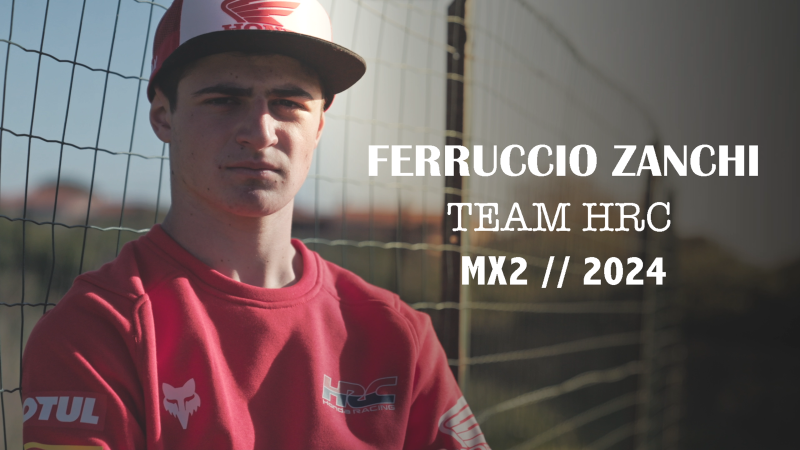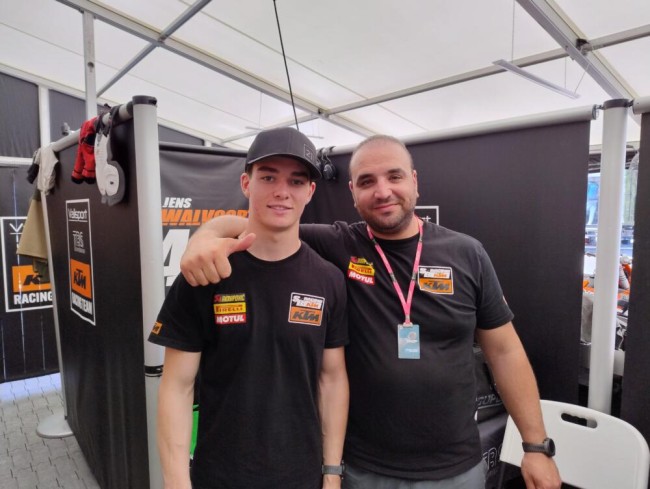The 2024 MXGP world championship calendar is on the verge of making an appearance and riders, teams and fans can expect another series that stretches to twenty rounds and strives for global reach. A list of Grands Prix can make perfect sense in some respects. For example, Italy have hosted multiple events in a single season for over ten years simply because of the demand and attention around Tony Cairoli. Spain has a busy event on a temporary structure outside of Madrid to accommodate the growing fandom for Jorge Prado. The presence of French, Belgian and Dutch riders in both MXGP and MX2 classes keep strong fixtures in those respective countries. GPs in Sweden, Latvia, Finland, Germany, Czech Republic and Switzerland are helping attract and progress racers from different regions, particularly eastern Europe. In the final top ten 2023 ranking of the EMX125 European Championship there are two Danes, a Czech, a Hungarian and the series was won by a Latvian.
For promoters Infront Moto Racing stitching together a world championship blanket can mean an intricate weave of patches and fabrics. MXGP is, of course, a business, and some Grands Prix make money, others less so. Infront have their own staff, logistics and TV production costs. Some promoters fulfil a full period of a contract, others struggle to pay the terms and disappear, leaving Infront chasing holes in the bottom line. The Grand Prix of Qatar was a huge government subsidised project that ran for half a decade between 2013-2017 and the fees of the event apparently covered the diminutive costs of five other GPs on the calendar each year. Lusail was not a hotbed of passion for the sport nor gathered many fans but it had the floodlit novelty factor and it ticked a budget box for the promoter, as well as being justified as an attempt to take MXGP to a new market.
Then there was the pandemic. For three years MXGP has shifted and pivoted with restrictions and rules, delays and cancellations. The promoters amazingly fashioned a plan of triple headers and double headers to get 2020 and 2021 championships on the record and, finally, in 2023 have been able to work with a degree of normality and have seen decent crowd attendances this year.
In an effort to know a bit more about how an MXGP schedule forms, we were grateful for the access to CEO David Luongo, who – to his credit – is always very open to discuss such matters. Adam Wheeler occupied twenty minutes of his time to ask what the complicated job entails.
OK, so, visits by President in Czech Republic, the Sport Minister in Belgium: government money plays a big part in the organisation of international sport events but each fixture of a 20-round calendar has its own creation story right?
That’s right. Many times the promoter is not the only one bringing the money to make it happen. There are two main ways to make a GP. In Europe it is the ‘classic’ way where the ticketing brings the main revenue for the organiser and they do a business plan where they have that ticketing income, the marketing and sponsorship on-site. When we go outside of Europe it tends to be a different approach because MXGP is bringing exposure, commerce and tourism to the place where we go. We also grow the sport or have presence in an important market and leads to some interest and/or growth in the fanbase there. Every GP has its own story, for sure. It is the most important off-road event in that country; in the Czech Republic it was the biggest event of the year for them. The Grand Prix is anticipated for a year and there is a big effort to make it as good as it can be. This is a general trend, and we put all of these together to make a championship.
The crowds seemed to be good in MXGP this year, so is ticketing is still a reliable model for this sport, and for sports generally?
Yeah. I think this year was like a pre-Covid season and in many places we even had an increase compared to before 2019. In France, for example, was very good. In Belgium and Germany also. Pre-sales have been strong and Saturdays are better. We’ve seen a lot of increase…but Italy has been [just] stable because we need to build-up new stars although [Andrea] Adamo is on the way, [Mattia] Guadagnini was missing but there is a new generation coming. On the other hand, Spain is growing like crazy because of [Jorge] Prado and [Ruben] Fernandez. In general, 2023 has been really positive.
Is it frustrating then that you have stars like Tim Gajser but cannot get reach into countries like Slovenia?
Well, I look at it the other way and we are seeing the base of what we built with the European Championship. We never wanted to be hard-linked to just one or two countries because of riders. We wanted to have as many nationalities as possible. When you see the top tens now of MXGP and MX2 you have seven-eight different nationalities. There is talent coming from many different places and for us this is fantastic because we touch almost all the countries or regions in Europe, and that’s because of the 125s and European classes that bring riders from everywhere. It also has a roll-on effect for the skills of the riders because in the past it would just be the Benelux riders winning on sand and the Italians and French owning the hard-pack. Now you don’t know who will be good and where! The level has risen and that helps with interest and also gives us more possibilities. For sure Tim is missing his home GP, that’s clear, but we can never ‘say never’ because we are in discussion with the Slovenian Federation and maybe one day we will have a race for him there.
You must have interesting discussions with different projects, groups and promoters…
For sure. What is important is that, to make a great Grand Prix, both parties need to be happy. We cannot make a GP just because we want to, and it ends up killing the organiser. That is very short-term, and we want to try and build long-term projects and partners. For that, a GP needs to be financially sustainable. The cases of Vietnam and Oman are examples of exactly that: we arrived to a point where we clearly understood that the race would not have been sustainable for them and it was a good decision to cancel and postpone. For Vietnam we were less than six months away from the GP and we could see that it was not going in a good way. So, to avoid problems with the costs of travelling it was better to postpone and see what could be done in the future.
Another balancing point is the costs of the event versus the benefits for your business. This is what Infront Moto Racing are here for after all, and that means judging carefully the amount of races and the geography…
You know, if you look now at motorsports then there are more races, and more series are looking outside of Europe. F1 is reaching 25 GPs now, MotoGP will also be more than 20. We are capped with the FIM contract at 20 races plus the Motocross of Nations. For us it is clear that we need to go to this limit of twenty races. The history of our sport is also important to us and we have been managing it for almost forty years now and I was checking the past calendars; in the 1990s there was an average of 13-14 GPs per year and today we have 20 per year. So, it’s not like we have taken away any of the classic European races to put Argentina or Indonesia instead. We were able to add them, which is what we need to be a global championship and to continue to try and extend and grow the motocross base. When you go to Argentina then you see 35,000 people at the GP and it’s an important motorcycle market. Even though it is a difficult financial time for the country right now, the GP was a success. Indonesia is one of the biggest markets in the world for Honda and Yamaha. Yes, most of those are scooters but they also have bigger capacity bikes and off-road bikes. It is a fantastic tool to promote and grow an academy or race series or talent for the future. So, there is a link. And there are other links coming, like Australia and China again in the future. Where the [motorcycle] market and sport are connected then we arrive. The best picture for us is 14 European races and 6 overseas. This is the perfect target and to try and minimise the cost and to be more efficient with back-to-back ‘doubles’ when we are overseas.
How do you feel about the Middle East? For many sports it seems to be an active and lucrative zone…
We had in the past in Qatar-
Yes, it was a five-year deal…
Yes, and we’ve been in talks with different countries there for a few years but nothing is finalised. At least one race in the Middle East would be a good target.
The U.S. has its own story for MXGP but are there any other markets where you want to be present? Brazil has a nice history in the championship, Russia was ambitious and now difficult, Australia remains untapped since 2001…
I believe the biggest area where we have potential in the years to come is Southeast Asia. This is the feeling we have between Thailand, Vietnam, Indonesia and then China, Philippines and those countries because they are very fast growing and dynamic and with people that love motorcycles. They are not so restrained by rules like we are in Europe for track, infrastructure and freedom to create events. They have more possibilities and that is more positive for motocross. Also South America, for us. But the problem there is that many times you face the currency depreciation which goes quite crazy in some places. That’s a problem for the GP at international level. For a global picture you face global challenges
What about Japan? It’s been sixteen years now since the world championship was last there…
Yeah, but Japan means a race that has to be discussed with the manufacturers directly because they own the tracks. It’s something that needs to be in their plan of promotion for sport. At the moment they are investing more in their racing programmes than in events. But, again, we have constant talks with many people so it is just a matter of timing for us to have a race there.
Infront Moto Racing is the third iteration of the promoting group in control of this sport and you are now up to 150 people contracted to help make it happen. Does that mean each Grand Prix has to make a good return and have a solid contract in place?
The thing with motocross is that you are not F1! In F1 they can engage costs because they know they will ask a fee to the local promoter and they can build their budget on that. For motocross you still deal with an association, and a motoclub at the same time as local government. You have to be very agile and flexible race-by-race. We have very different agreements. Some are based on ticketing, some on fixed fees and it depends on the market, the country and the costs we have to go there. When we go overseas the costs are not the same as going to Lommel or Trentino! Every proposal and collaboration is made around the place we go.
We see sports shifting in shape, F1 have Sprints and MotoGP now also-
They copy us!
The points you have on Saturday for qualifying heats now are a modification but are there any ideas, discussions or thoughts to change the shape of MXGP? The SuperFinal concept was good-
But in reality it was difficult because of the difference of speed. What I see now is that it is always good to be thinking about the sport and to have input, and to also be – how to say? – a ‘pioneer’ in some ways. But our sport is also one with tradition, and I think this is a value that is being lost in society generally. F1, MotoGP, MXGP are sports that have been through the decades, and they also link people that have a love of motorsport. So, we have to be careful that we don’t go in a way that we lose this tradition. For me, MXGP is a two-day event format. We have families that come in campers and vans to make a weekend experience and enjoy racing for two days. I think the fans in general want to see races, they don’t want to see timed laps or Superpole. We saw from the first moment we put the Saturday Qualifying race in 2008 or 2009 that we had an increase in attendance by 30% and this showed that people wanted to see that race. The points system this year added a bit to the ‘show’ of the championship and the classification of MXGP might have looked a bit different without it. There are riders who are more ‘sprint’ and others who are more endurance and it balances out at the end of the weekend. To see a big revolution in the future? I think we already have a good balance with the classes and the ages. We just need to focus on details and how we can improve the presentation and how spectators can have a better experience with us and – this is important to me now – to work on the relationship between the riders and the spectators. I really want to keep this close link, which is unique to motocross, where the fans can see, talk, touch and interact with the stars in the paddock. They can feel that they are people that they can talk to. In other motorsports there is a ‘wall’ between the fan and the rider or driver. We started with the Paddock Show this year, which we need to continue to improve, and we need to find other ways to entertain the spectators during the weekend onsite.
How about changing the TV package and presentation? It seems like it has been the same for many years now apart from the decent additions of the drone and the ‘Behind the Gate’ series. How about a new format? Some live-streaming?
Well, the first step was the 26 minute Behind the Gate programme, which I mention because I really feel it lifted the level for this kind of show and we have seen the feedback that is very positive. We want to continue to improve that. We almost doubled the TV post-production crew to make this show because you need resources to do it. The live feed is a bit more complicated because we are restricted by the slot that we get. F1 and MotoGP can be on for 12 hours live and with MXGP we only have our four-hour slot and some broadcasters only take a two-hour slot. We don’t have the freedom to create a ‘freestyle’ show where we can move a lot of hours and go from the studio to the track. We have to have a usable and slick package that can be taken by international TV. It helps MXGP to be attractive to main broadcasters. Then, for onsite production, we can improve with more behind-the-scenes content during the weekend.
What about more live-streaming?
For the racing we see that MXGP-TV continues to grow each year and this is the best way for the fans to get access. We made some promotion during the year where we put some free content on Youtube and Facebook but, for me, the racing has to stay as premium content for now. We don’t have the revenue from TV channels that other sports have where the TV rights almost cover all the costs involved. In MXGP we pay for those because we simply don’t have that income from TV. So, it’s really something where we are looking for visibility rather than revenue. This is the difference compared to other sports.
Lastly there was much talk and enthusiasm during 2022 for a Grand Prix and AMA Pro National one-event collaboration. It gone a bit quiet since. Is the scheme still alive?
It is something we are talking about now but it was a project that became a bit frozen during the launch of SMX. All the energy and attention has been put on the collaboration between MX Sports and Feld and that’s their top priority at the moment. The Motocross of Nations was a success in the USA so we found a very good event to do together and there is no doubt we will continue in that way and try to improve it. At the last edition in RedBud Feld was also involved and that led to a good collaboration between the three of us, then for another event in the USA – like a GP but in a good way – it would be to have a project like the one we are thinking about. I believe it is the dream of every motocross fan because you’d have the best line-up ever of GP and Outdoors but any project is always about the people involved and I’m very sure the conversation will continue.
You can see the 2024 MXGP provisional calendar below:
Interview: Adam Wheeler
Image: MXGP/Infront Moto Racing


















